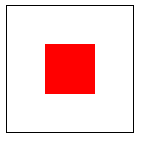第一种:
用css的position属性
<style type="text/css">
.div1 {
width: 100px;
height: 100px;
border: 1px solid #000000;
position: relative;
}
.div2 {
width: 40px;
height: 40px;
background-color: red;
position: absolute;
margin: auto;
top: 0;
left: 0;
right: 0;
bottom: 0;
}
</style>
<div class="div1">
<div class="div2 ">
</div>
</div>
效果图:

第二种:
利用css3的新增属性table-cell, vertical-align:middle;
<style type="text/css">
.div1 {
width: 100px;
height: 100px;
border: 1px solid #000000;
display: table-cell;
vertical-align: middle;
}
.div2 {
width: 40px;
height: 40px;
background-color: red;
margin: auto;
}
</style>
<div class="div1">
<div class="div2">
</div>
</div>
效果:

第三种:
利用flexbox布局
<style type="text/css">
.div1 {
width: 100px;
height: 100px;
border: 1px solid #000000;
display: flex;
/*!*flex-direction: column;*!可写可不写*/
justify-content: center;
align-items: center;
}
.div2 {
height: 40px;
width: 40px;
background-color: red;
}
</style>
<div class="div1 ">
<div class="div2 ">
</div>
</div>
效果:

第四种:
利用transform的属性(缺点:需要支持Html5)
<style type="text/css">
.div1 {
width: 100px;
height: 100px;
border: 1px solid #000000;
position: relative;
}
.div2 {
height: 40px;
width: 40px;
background-color: red;
position: absolute;
top: 50%;
left: 50%;
-ms-transform: translate(-50%, -50%);
-moz-transform: translate(-50%, -50%);
-o-transform: translate(-50%, -50%);
transform: translate(-50%, -50%);
}
</style>
<div class="div1 ">
<div class="div2 ">
</div>
</div>
效果图:

到此这篇关于CSS盒子居中的常用的几种方法(小结)的文章就介绍到这了,更多相关CSS盒子居中内容请搜索以前的文章或继续浏览下面的相关文章,希望大家以后多多支持!



